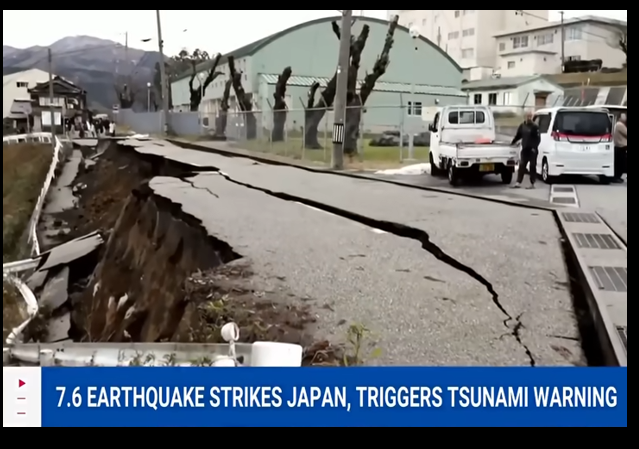Japan Begins Recovery Efforts After New Year’s Day Swarm of Earthquakes
Country reeling from 150 quakes in the last 24 hours.

New Year’s 2024 in Japan was marred by a massive earthquake swarm, beginning with one 7.6 Richter Scale shaker and then over 100 smaller quakes.
As daylight broke across Japan this morning the full destruction of the deadly 7.6 magnitude earthquake was laid bare showing collapsed homes, toppled temples and huge cracks in the middle of roads.
White smoke continued to rise from the charred remains of buildings, as the country woke to the horrific aftermath after being hit with 150 quakes in less than 24 hours.
The New Year’s Day disaster left at least 13 people dead in the Ishikawa Prefecture according to the Japan Times, with dozens more injured and unaccounted for as emergency workers plough through rubble to try and find survivors.
One building, believed to be a seven-storey block, was seen lying on its side while a temple in Suzu City is said to have been completely destroyed. In popular tourist site Wajima City, in the Ishikawa Prefecture at least 100 buildings have been destroyed.
The images and videos capture the devastation.
Breaking: As daylight breaks, the aftermath of the #earthquake in Wajima City, #Japan, emerges, showing the destruction caused by a fire that razed more than 50 buildings.#Japonpic.twitter.com/fy8FHLhF7z
— Hsnain🍄 (@Hsnain901) January 2, 2024
Breaking: As daylight breaks, the aftermath of the #earthquake in Wajima City, #Japan, emerges, showing the destruction caused by a fire that razed more than 50 buildings.#Japonpic.twitter.com/fy8FHLhF7z
— Hsnain🍄 (@Hsnain901) January 2, 2024
Rescue efforts have been made more difficult due to badly damaged and blocked roads, and one of the area’s airports has been forced to close due to runway cracks.
Many rail services, ferries and flights into the area have also been suspended.
“The search and rescue of those impacted by the quake is a battle against time,” Prime Minister Fumio Kishida said during an emergency disaster meeting on Tuesday.
Kishida said rescuers were finding it very difficult to reach the northern tip of the Noto peninsula due to wrecked roads, and that helicopter surveys had discovered many fires and widespread damage to buildings and infrastructure.
The Japanese government downgraded its highest-level tsunami alert but warned residents not to return home as deadly waves and aftershocks could still occur.
The [Japan Meteorological Agency] initially issued a major tsunami warning for Ishikawa and lower-level tsunami warnings or advisories for the rest of the western coast of Honshu, as well as for the northernmost of the country’s main islands, Hokkaido.
The warning was downgraded to a regular tsunami several hours later, meaning the sea could still generate waves of up to 10 feet. Aftershocks could also slam the same area over the next few days, the agency said.
Here was the moment when one of the tsunami waves came along the Seki river, near Jōetsu, Japan (west coast) almost 60 mile away from the epicenter of this morning's violent 7.5M earthquake.
There are presently no tsunami warnings!
— Live Storm Chasers (@LiveStormChaser) January 1, 2024
The quake’s epicenter was Janan’s Noto Peninsula, which juts into the Sea of Japan from the nation’s main island of Honshu.
About 1,000 Self-Defense Force personnel are engaged in rescue and relief operations, Kishida said.
The earthquake was centered around 30 kilometers east-northeast of Wajima with a provisional depth of 16 km, registering a maximum 7 on the country’s seismic intensity scale, according to the Japan Meteorological Agency.
A level-7 quake is described as making it impossible for people to remain standing. Such a temblor was last recorded in 2018 in Hokkaido, the weather agency said.
 DONATE
DONATE
Donations tax deductible
to the full extent allowed by law.








Comments
I feel sorry for the people while remembering how Japan systematically destroyed America’s tech industry using unsavory tactics and illegal business practices. That was how they carried on WW2 after getting their tails kicked.
That is why, in the next global war America should drop the pursuit of liberty and plant Old Glory instead.
Rome knew that not all enshrine freedom.
Japan is probably the best-prepared nation for earthquakes. Imagine if a quake of this magnitude hit San Francisco or any other big US city.
San Francisco has stringent seismic code requirements, but you are right–a lot more could and should be done.
7.6 is significant, but how bad an earthquake is depends on a lot of factors beyond that measurement alone. Depth of quake, soil conditions, etc. all play big roles in how much damage is inflicted above.
It sounds like (while bad) Japan did not suffer that big of a loss compared to what could have been.
This is also a wake up call to take seismic code seriously. If this was in an urban area Turkey or Syria, the death toll would have been well into the 10s of thousands.